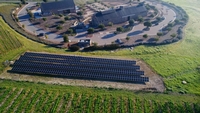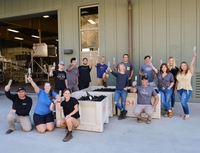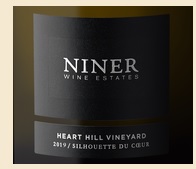A quick look at an Old World model is instructive here. In France, and in Burgundy in particular, many of the most sought-after wines come from what are known as “Domaines” – wholly owned and managed properties undertaking every aspect of wine production, quite literally from the ground up — as they work only with estate-grown grapes. The most famed of these is likely Domaine de la Romanée-Conti – known to fans as “DRC” – currently a collection of 7 vineyard sites totaling 63 acres. DRC traces its roots back nearly 400 years, and over time has adopted new vineyard and winemaking processes with an eye toward the long-term health and sustainability of the estate. Today the wines from DRC fetch prices of titanic proportions in the marketplace and are celebrated worldwide as site specific benchmark products.
That “Domaine” spirit is more than evident at Niner. President Andy Niner and his carefully assembled team are creating a new model that–while not trying to emulate DRC or anyone else–bodes well for securing something with staying power. It’s been my pleasure to visit the winery annually for several years  running, and while there aren’t any five-figure offerings in the portfolio as with DRC just yet, it’s clear that what’s happening at Niner is on an arc that continues to bend toward excellence in all aspects of the business.
running, and while there aren’t any five-figure offerings in the portfolio as with DRC just yet, it’s clear that what’s happening at Niner is on an arc that continues to bend toward excellence in all aspects of the business.
Andy’s parents Richard and Pam Niner got started in the area with a vineyard purchase in 2001, eventually opening the winery and tasting room in 2010. Today the winery holds estate vineyards in both the Willow Creek District and Geneseo District sub appellations of the Paso Robles AVA, with an additional vineyard site, Jespersen Ranch, south of San Luis Obispo that straddles two AVA’s – Edna Valley and the newly minted San Luis Obispo Coast AVA. The focus in the Paso Robles area is Cabernet Sauvignon, though Cabernet Franc, Petit Verdot, Malbec, Carmenere, Barbera, Sangiovese, Zinfandel and Grenache Blanc are also grown and produced in small quantities. Jespersen Ranch is planted to Chardonnay, Pinot Noir, Syrah, Grenache, Albariño and Sauvignon Blanc, and a recent planting of Pinot Meunier will be coming online soon.
This sounds like a lot to manage already, but there’s more to the estate as well. A top-flight restaurant on site uses quite a bit of estate produced food on its menu. If I haven’t yet directed you there for lunch, consider yourself notified. The  bread alone is enough to inspire a return visit, and the estate-informed menu begun by Chef Meagan Loring and currently carried by Chef Jacob Burrell is worthy of multi-visit exploration. When I write, “estate-informed,” I mean that they’ve tried growing their own wheat and raising their own chickens in the past, and are currently keeping honeybees and working on a verjus from second crop Zinfandel this year. There’s estate grown olive oil, and the estate gardener works very closely with the chef to grow items that will help the menu pair with the wines. It doesn’t stop there either: Working with a local coffee roaster, they produce barrel conditioned coffee beans by rolling green beans around in a barrel for several weeks prior to roasting, and just learned that steaming a barrel right before putting the beans in helps to strengthen the wine-y character of the roast.
bread alone is enough to inspire a return visit, and the estate-informed menu begun by Chef Meagan Loring and currently carried by Chef Jacob Burrell is worthy of multi-visit exploration. When I write, “estate-informed,” I mean that they’ve tried growing their own wheat and raising their own chickens in the past, and are currently keeping honeybees and working on a verjus from second crop Zinfandel this year. There’s estate grown olive oil, and the estate gardener works very closely with the chef to grow items that will help the menu pair with the wines. It doesn’t stop there either: Working with a local coffee roaster, they produce barrel conditioned coffee beans by rolling green beans around in a barrel for several weeks prior to roasting, and just learned that steaming a barrel right before putting the beans in helps to strengthen the wine-y character of the roast.
I’m sure you’re getting the general idea, so let’s return to wine. Niner employs two winemakers – one for the Paso Robles fruit, and one to make the wine from Jespersen Ranch. Patrick Muran focuses on the Cabernet and other Paso fruit at the winery just northeast of Heart Hill, and Molly Bohlman works with the Jespersen Ranch fruit, handling the reds from there in a separate building just across from the tasting room. The team also hand-riddles a small production of sparkling wine that is a true labor of love and a welcome addition to the tasting menu.
Andy and the team are in this game for the long haul, and Andy is most proud of the team that he’s been able to build over time. He describes them as “people who combine expertise with humility” who know what they know with depth and  know just as clearly what they don’t know—maintaining a keen interest continued learning for the good of the estate. This aligns with the enterprise’s long term focus and a disciplined pursuit of that focus in the face of increasing industry pressures to go for the quick cash. This in turn makes everyone on the team a “doer” (I’ve witnessed Andy busing tables on the patio), and everyone pitches in when and where needed.
know just as clearly what they don’t know—maintaining a keen interest continued learning for the good of the estate. This aligns with the enterprise’s long term focus and a disciplined pursuit of that focus in the face of increasing industry pressures to go for the quick cash. This in turn makes everyone on the team a “doer” (I’ve witnessed Andy busing tables on the patio), and everyone pitches in when and where needed.
Sustainability isn’t just a buzzword, or a quick certification grab here – it’s serious business. Two examples show this clearly. Niner has been able to reduce their water usage drastically over the past ten years, and the winery itself has an elaborate water collection system that gets almost every drop of roof runoff from every building. Monitoring of moisture levels in vineyard soils permits Patrick and Molly to make sure the vines get the desired amount of “struggle factor” so that flavor concentration lands just where they like it, but enough water at the right time to keep the biome in good health. On the people side, Niner kept their entire staff on board across all the pandemic closures while similar businesses imposed significant layoffs. This strategy is now paying dividends, allowing Niner to resume full operations while others scramble to staff back up.
Looking forward, Andy is most focused on the raw details of executing the long-term plan, calling it a simple model where improvements are made incrementally and small adjustments continue to move toward excellence, so that visitors can leave the estate having enjoyed an outstanding experience. Combine that with his excitement about the team’s potential and it seems that the sky’s the limit. “We’re going to look internally and do the best job that we can. Does that mean we’re stupid?”
I’ll leave you with a review of one of my favorite current offerings – you’ll find others in the archives here at Wine Review Online, and no doubt there will be more to come. It may take a while for “NWE” to approach “DRC” as commonly used code for the highest quality wine, but don’t bet against that happening at some point.
 Niner Wine Estates, Willow Creek District, Paso Robles (Central Coast, California) Heart Hill Vineyard “Silhouette Du Coeur” 2019 ($50): A lively nose of white flowers, pear and nectarine all translate to flavors in a dry style with a creamy mid-palate and a crisp finish that brings a little oak toast and spice to the fore. Partial malolactic fermentation keeps freshness while adding gravitas, resulting in a wine with real push but also elegance. It shows that winemaker Patrick Muran is truly coming into his own. Contains 52% Grenache Blanc, 33% Marsanne and 15% Roussanne. 14.2% alcohol. 95 Points
Niner Wine Estates, Willow Creek District, Paso Robles (Central Coast, California) Heart Hill Vineyard “Silhouette Du Coeur” 2019 ($50): A lively nose of white flowers, pear and nectarine all translate to flavors in a dry style with a creamy mid-palate and a crisp finish that brings a little oak toast and spice to the fore. Partial malolactic fermentation keeps freshness while adding gravitas, resulting in a wine with real push but also elegance. It shows that winemaker Patrick Muran is truly coming into his own. Contains 52% Grenache Blanc, 33% Marsanne and 15% Roussanne. 14.2% alcohol. 95 Points
